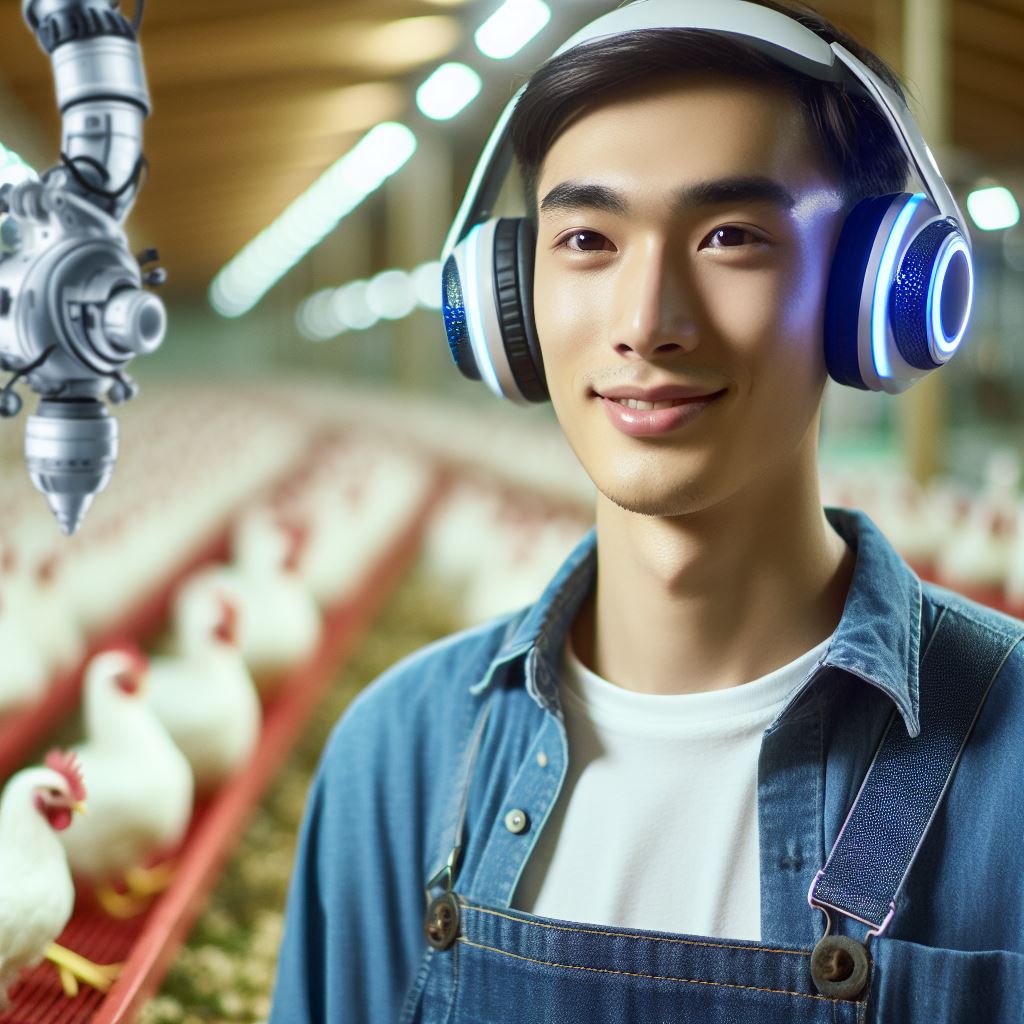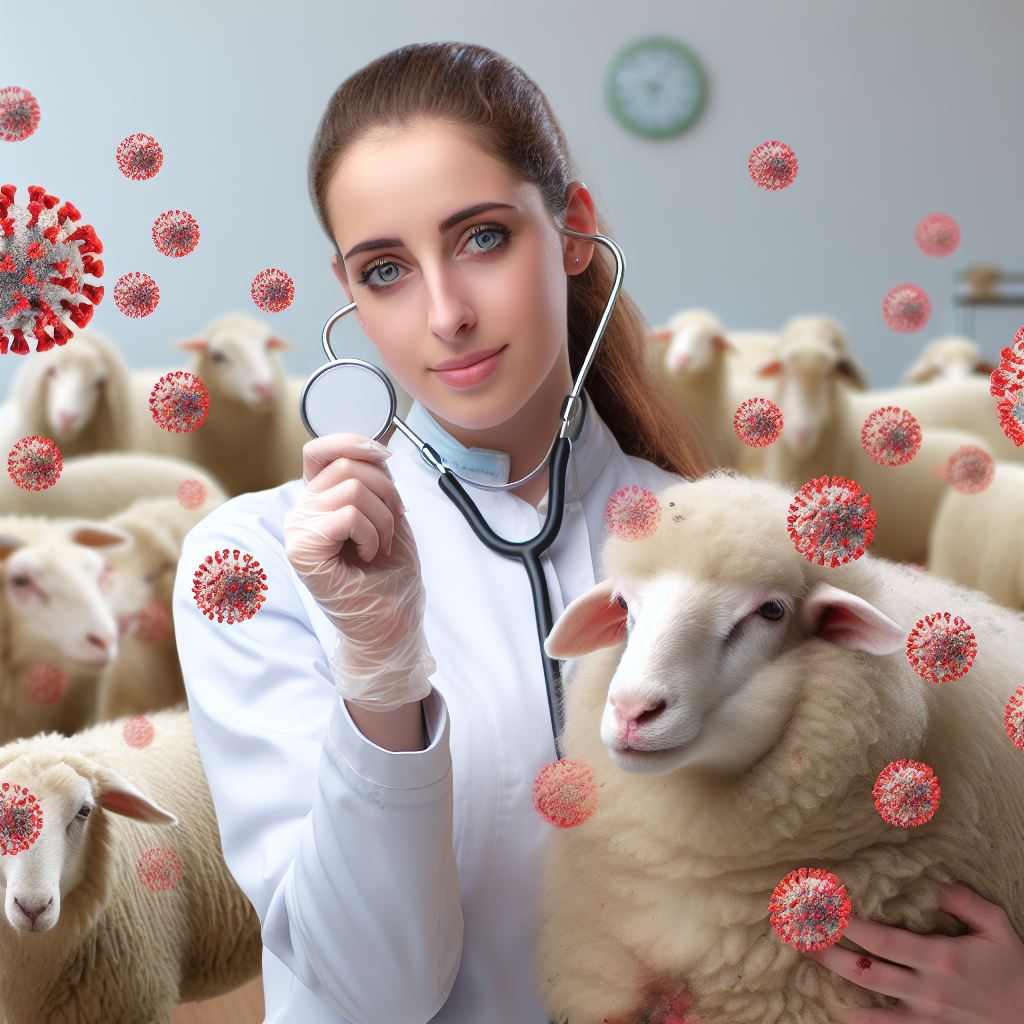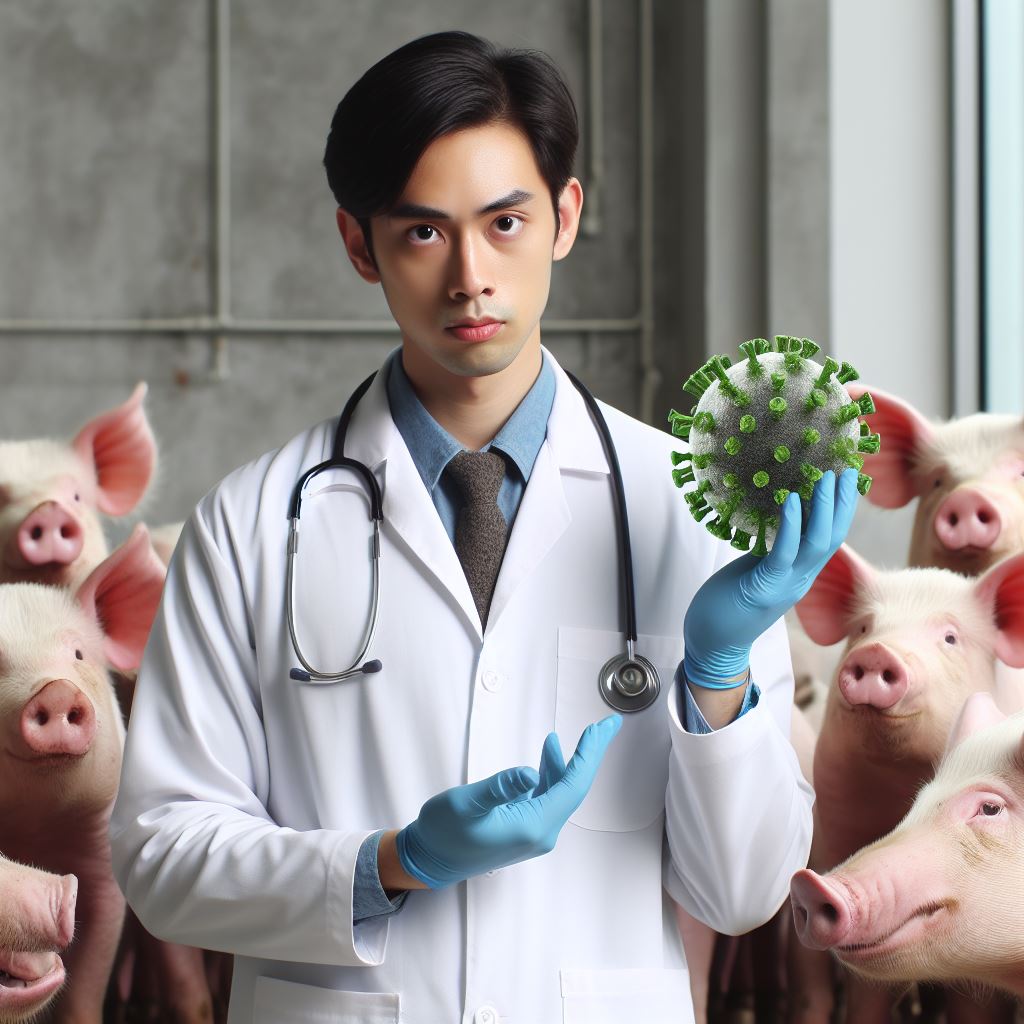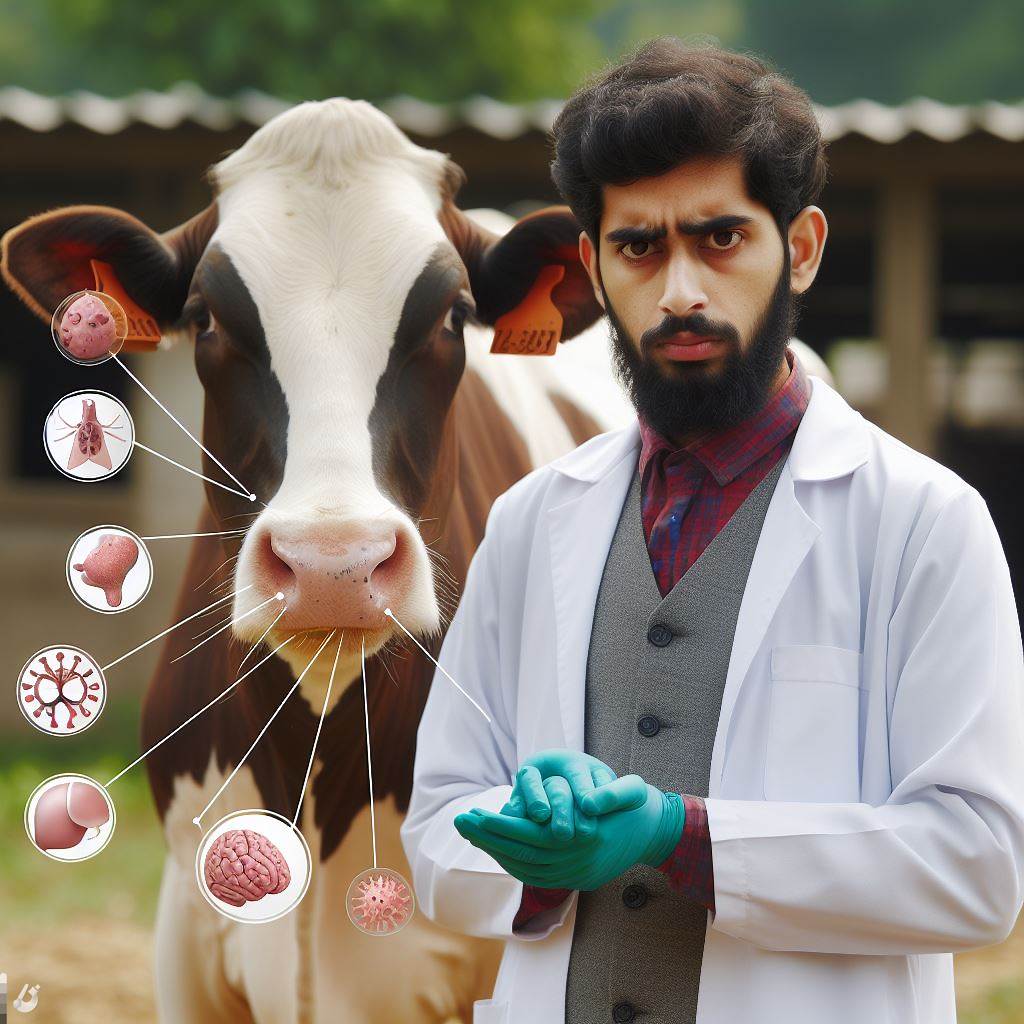Introduction
Let’s explore Robotics in Poultry Farming: The Future Is Here.
Robotic technology has revolutionized the poultry farming industry, with its potential to significantly impact productivity and efficiency.
By automating various tasks, robotics can overcome challenges and bring groundbreaking advancements.
This article highlights the significance of robotics in poultry farming and the positive changes it can bring.
Introduce the topic of robotics in poultry farming
Robotic technology in poultry farming is a game-changer, providing innovative solutions to industry challenges.
With the ability to automate tasks such as egg collection, feeding, and cleaning, robotics eliminates the need for labor-intensive manual work.
The significance and potential impact of robotics in the industry
The impact of robotics on poultry farming is tremendous, maximizing productivity and reducing costs.
By utilizing robots, farmers can monitor and analyze data in real-time, making informed decisions to optimize production.
Robotic systems can enhance animal welfare by providing precise control over temperature, lighting, and ventilation.
The use of robotics also improves biosecurity, minimizing health risks by reducing human contact with birds.
Moreover, robots can navigate through narrow spaces and perform tasks swiftly, ensuring efficient operations in confined poultry houses.
In addition to increasing efficiency, robotics offers greater precision in tasks like vaccination and disease detection.
The potential of robotics in poultry farming extends beyond the farm, with autonomous drones monitoring fields and identifying pests.
Overall, the integration of robotics in poultry farming brings a new era of enhanced productivity, efficiency, and animal welfare.
As technology continues to evolve, the future of robotics in the industry looks promising, with even more possibilities for advancements.
Transform Your Agribusiness
Unlock your farm's potential with expert advice tailored to your needs. Get actionable steps that drive real results.
Get StartedIn the coming years, we can expect to witness a significant transformation in the way poultry farming operates, thanks to the introduction of robotics.
Benefits of Robotics in Poultry Farming
Robotics in poultry farming has revolutionized the industry by providing numerous benefits to farmers.
With increased efficiency, improved animal welfare, reduced labor costs, and enhanced data collection and analysis, the future of poultry farming is looking brighter than ever.
Increased Efficiency and Productivity
- Robotic systems can perform tasks faster and with greater precision, resulting in increased efficiency.
- Automated processes such as feeding, egg collection, and cleaning save time and effort for farmers.
- With robotics, poultry farms can operate 24/7, maximizing production and ultimately leading to higher productivity.
Improved Animal Welfare
- Robots can provide individualized care for each bird, monitoring their health and well-being.
- Automated systems ensure consistent access to food and water, reducing stress and promoting healthier livestock.
- Noise and disturbances can be minimized, creating a calmer environment for the poultry.
Reduction in Labor Costs and Workload
- Robotic systems decrease the need for manual labor, reducing the costs associated with human workforce.
- Farmers can reallocate their time to more important tasks such as strategic planning and business development.
- The workload becomes more manageable, allowing farmers to focus on improving overall farm operations.
Enhanced Data Collection and Analysis for Better Decision-Making
- Robotic sensors gather real-time data on various aspects of poultry farming, such as temperature, humidity, and feed consumption.
- Analyzing this data provides valuable insights for making informed decisions and optimizing farm performance.
- Farmers can identify potential issues early on, preventing diseases or other problems from spreading.
Therefore, the integration of robotics in poultry farming offers numerous advantages.
The increased efficiency and productivity, improved animal welfare, reduced labor costs, and enhanced data collection and analysis all contribute to the industry’s growth and success.
As technology continues to advance, the future of poultry farming looks promising.
By embracing robotics, farmers can ensure a sustainable and profitable business while providing better care for their livestock.
Read: Pig Behavior: Understanding Your Herd
Types of Robotics Used in Poultry Farming
In the ever-evolving realm of agriculture, robotics has made its way into poultry farming, revolutionizing the industry.
With the advancement of technology, farmers can now utilize robots to streamline various tasks, improving efficiency and productivity.
Here are some of the types of robotics used in poultry farming:
Automated feeding systems
- These systems ensure that the poultry receive the required amount of feed at the right time.
- They use precision sensors and algorithms to monitor and control the delivery of feed.
- This not only reduces labor costs but also minimizes feed wastage, resulting in significant savings for farmers.
Robotic cleaning and disinfection
- Cleaning and disinfecting poultry houses is a crucial aspect of maintaining a healthy and hygienic environment.
- Robots equipped with brushes and sprayers can efficiently clean and sanitize the facilities.
- They can navigate through the poultry houses, reaching every nook and corner, and eliminate the need for manual labor, saving time and effort.
Egg collection and sorting robots
- Traditional egg collection is a labor-intensive process that is time-consuming and prone to errors.
- Robotic systems have been developed to automate this process, ensuring gentle handling of eggs.
- These robots can accurately collect and sort eggs based on criteria such as size, weight, and quality.
- By eliminating human involvement, the risk of eggs getting damaged or wrongly categorized is significantly reduced.
Automated disease detection and treatment
- Early detection of diseases is crucial for preventing widespread outbreaks, minimizing losses, and ensuring animal welfare.
- Robotics in poultry farming now includes intelligent systems that can monitor the birds’ health and detect signs of diseases.
- These robots use various sensors to analyze vital parameters and behavior, providing early warnings to farmers.
- Additionally, some advanced robots can even administer vaccines or medications, ensuring prompt treatment of affected poultry.
Generally, robotics in poultry farming is transforming the industry by offering efficient and automated solutions to various tasks.
From automated feeding and cleaning systems to egg collection and disease detection robots, the future of poultry farming is here.
Embracing these advancements will not only improve productivity but also enhance animal welfare, farm management, food safety, and overall profitability for farmers.
Read: Layer vs. Broiler: Choosing Your Poultry Path
Case Studies
In recent years, robotics has made significant advancements in various industries, including poultry farming.
By incorporating robotics into poultry farms, farmers have experienced numerous benefits and improved their farming practices.
Successful implementation of robotics in poultry farms
The implementation of robotics in poultry farming has showcased its effectiveness in improving farming practices:
- Increased efficiency: Robots, such as FarmBot and Eggy, have automated time-consuming tasks, reducing labor costs and enabling farmers to focus on other essential aspects of poultry farming.
- Improved accuracy: Robotic systems ensure precise feed distribution, vaccination, and egg collection, minimizing human errors and improving the overall quality of poultry products.
- Enhanced animal welfare: Robots, like the Henhouse Robot, create a controlled environment that optimizes bird health and comfort by regulating temperature, humidity, and ventilation.
- Enhanced farm security: Drones equipped with surveillance capabilities provide a real-time monitoring system, identifying potential threats to the poultry farm and allowing farmers to take immediate action.
Real-life examples and their positive outcomes
This article will explore some successful case studies that highlight the positive outcomes of implementing robotics in poultry farming.
FarmBot is an autonomous robot designed for precision farming.
It has been successfully implemented in poultry farms to automate the process of feeding and monitoring the birds.
This robotic system ensures consistent and accurate distribution of feed, optimizing the birds’ growth.
Eggy is a robotic device that automates the egg collection process in poultry farms.
It navigates through the barn and collects eggs, reducing labor costs and increasing efficiency.
Showcase Your Farming Business
Publish your professional farming services profile on our blog for a one-time fee of $200 and reach a dedicated audience of farmers and agribusiness owners.
Publish Your ProfileThe introduction of Eggy has significantly improved egg production in various poultry farms.
The Henhouse Robot is an automated system that monitors and maintains the poultry house environment.
It controls ventilation, temperature, and humidity, creating an optimal living condition for the birds.
This technology has led to better flock health and increased egg quality.
Some poultry farms have incorporated drones for surveillance purposes.
Drones equipped with cameras monitor the farm’s perimeter and identify any potential threats, such as predators or intruders.
This innovation has effectively reduced poultry losses and improved overall farm security.
Robotic systems are being utilized for vaccinating poultry.
These robots precisely administer vaccines to the birds, reducing errors and ensuring proper immunization.
This method has resulted in higher vaccination success rates and improved flock health.
Showcase the effectiveness of robotics in improving farming practices
Embracing the future, robotics revolutionizes poultry farming, showcasing its effectiveness through:
- Precision Feeding: Robots ensure accurate feed distribution, optimizing nutrition for healthier and more productive poultry.
- Automated Monitoring: Sensors and cameras provide real-time data on poultry health, enabling prompt intervention and disease prevention.
- Egg Collection Efficiency: Robotic systems streamline egg gathering, enhancing efficiency and minimizing human labor in the process.
- Improved Animal Welfare: Robots create ideal environments, monitoring and adjusting conditions for the well-being of the poultry.
- Labor Reduction: Automation reduces reliance on manual labor, allowing farmers to allocate resources more strategically and efficiently.
- Enhanced Data Analytics: Robotics generates valuable data for informed decision-making, contributing to farm management optimization.
- Sustainable Practices: Efficiency gains lead to resource conservation, promoting sustainability and reducing the environmental footprint of poultry farming.
- Precision Vaccination: Robotic systems administer vaccines precisely, ensuring each bird receives appropriate immunization, thus improving overall flock health.
- Minimized Stress: Automated processes minimize disturbances, creating a stress-free environment that positively impacts poultry growth and production.
- Increased Productivity: The combined impact of precision, efficiency, and enhanced welfare contributes to increased poultry productivity.
Robotics emerges as a transformative force in poultry farming, revolutionizing practices and propelling the industry towards a more sustainable and technologically advanced future.
In general, robotics has revolutionized the poultry farming industry.
Through successful case studies and real-life examples, the positive outcomes of implementing robotics in poultry farms have become evident.
The effectiveness of robotic systems in improving farming practices, increasing efficiency, and enhancing animal welfare are undeniable.
With the continuous advancements in robotics, the future of poultry farming looks promising.
Read: Poultry Management: Key Techniques

Find Out More: Horse Breeding: Genetics for Performance
Explore Further: Goat Hoof Trimming: A Step-by-Step
Challenges and Limitations
Potential challenges faced in adopting robotics in poultry farming
- Limited adaptability of robotic systems to diverse poultry farm layouts and configurations.
- Handling variability and unpredictability in poultry behavior and movement patterns.
- Ensuring robots can effectively navigate cramped spaces and tight corners within poultry houses.
- Developing robust algorithms to enable accurate identification and manipulation of poultry.
- Integrating multiple robotic systems to work collaboratively without interference or collisions.
- Maintaining optimal animal welfare while using robotic technologies, such as minimizing stress and ensuring proper handling.
Addressing concerns related to cost, technical issues, and maintenance
- High upfront costs of acquiring and installing robotic systems may pose financial challenges for farmers.
- Integration of robotics requires expertise in robotics, computer vision, and artificial intelligence.
- Ensuring reliable battery life and power supply to support continuous operation of robotic systems.
- Regular maintenance and servicing to keep robotic systems in optimal working condition.
- Potential disruption in operations due to technical malfunctions or software bugs that need troubleshooting.
- Providing comprehensive training to farm operators and workers to operate and maintain robotic systems effectively.
Areas that may require further research and development
- Enhancing the intelligence of robotic systems to handle complex farm environments and changing conditions.
- Designing robots with improved dexterity and adaptability to handle varying sizes and breeds of poultry.
- Developing advanced imaging and sensing technologies to better perceive and interact with poultry.
- Creating data analytics tools to process the vast amount of data generated by robotic systems.
- Improving communication interfaces between robotic systems and human operators for seamless collaboration.
- Addressing biosecurity concerns associated with introducing robotics into poultry farms to prevent disease outbreaks.
Basically, while robotics in poultry farming offers numerous benefits and advancements, there are also challenges and limitations that need to be addressed.
Overcoming these obstacles requires ongoing research and development, collaboration between experts in various fields, and continuous innovation in robotics technologies.
By addressing the challenges and limitations, the future of poultry farming can indeed be revolutionized by the integration of robotics.
Read: Goat Rearing: Tips for Best Results
Future Prospects and Innovations
Future trends and developments in robotics for poultry farming
Looking ahead, the future of robotics in poultry farming holds exciting trends and developments, including:
- AI Integration: Artificial intelligence will enhance robotic systems, enabling smarter decision-making and adaptive responses to poultry needs.
- Swarm Robotics: Coordinated groups of robots will work collaboratively, optimizing tasks like monitoring and herding within poultry farms.
- IoT Connectivity: The Internet of Things will connect robotic devices, facilitating seamless data sharing and real-time monitoring for improved farm management.
- Autonomous Vehicles: Robotic vehicles will navigate poultry farms independently, performing tasks like feeding, monitoring, and cleaning with increased efficiency.
- Customization for Poultry Species: Specialized robots tailored to the needs of different poultry species will ensure optimal care and management practices.
- Advanced Imaging Technologies: High-tech cameras and sensors will provide detailed imaging, enabling precise health assessments and early detection of issues.
- Robotics in Breeding Programs: Automated systems will play a role in poultry breeding, enhancing genetic selection processes for improved productivity and health.
- Disease Detection Drones: Drones equipped with sensors will monitor flocks for signs of disease, allowing swift and targeted responses to potential outbreaks.
- Eco-Friendly Robotic Solutions: Sustainability will drive the development of energy-efficient and eco-friendly robotic systems to minimize environmental impact.
- Global Adoption: The widespread adoption of robotics in poultry farming will become a global phenomenon, transforming the industry on a large scale.
As we embrace these advancements, the future of poultry farming will undoubtedly witness a paradigm shift, with robotics playing a pivotal role in shaping a more efficient, sustainable, and technologically advanced landscape.
As the world of robotics in poultry farming continues to evolve, future prospects and innovations hold immense potential for the industry.
Emerging technologies like artificial intelligence and machine learning
In the realm of poultry farming, emerging technologies like artificial intelligence (AI) and machine learning (ML) are revolutionizing operations:
- Smart Monitoring Systems: AI-driven monitoring systems use cameras and sensors to assess poultry health and behavior.
- Predictive Analytics: Machine learning algorithms analyze data patterns, predicting potential health issues and optimizing farm management.
- Automated Feed Systems: AI-driven feed systems adjust portions based on individual bird needs, reducing waste and ensuring nutritional balance.
- Facial Recognition for Health Monitoring: Cameras equipped with facial recognition technology monitor individual bird health and detect early signs of illness.
- Robotic Vaccination: AI-assisted robotic systems can accurately administer vaccinations, ensuring precise dosages for each bird.
- Behavioral Analysis: Machine learning algorithms analyze poultry behavior, identifying patterns that indicate stress, disease, or environmental concerns.
- Adaptive Climate Control: AI-powered climate control systems adjust environmental parameters based on real-time data, optimizing conditions for poultry well-being.
- Egg Quality Prediction: Machine learning models assess various factors to predict egg quality, aiding in efficient sorting and processing.
- Drone Surveillance: Drones equipped with AI analyze farm landscapes, providing insights into crop health, infrastructure, and potential issues.
- Data-Driven Decision-Making: The integration of AI and ML enables farmers to make informed decisions, enhancing overall efficiency and productivity.
These cutting-edge technologies exemplify the transformative impact of AI and ML in poultry farming, paving the way for a future where innovation ensures the well-being of both farmers and their feathered charges.
Predict potential advancements and their impact on the industry
Anticipating the trajectory of robotics in poultry farming reveals exciting advancements poised to reshape the industry:
- Enhanced AI Precision: Future AI systems will exhibit heightened precision in monitoring poultry health and behavior.
- Swarm Robotics: Collaborative swarms of robots will efficiently perform tasks like cleaning and monitoring in poultry houses.
- Genetic Selection with AI: AI will play a pivotal role in refining genetic selection processes, optimizing bird traits for better productivity.
- Autonomous Poultry Handling: Advanced robotics will allow for autonomous handling of poultry, minimizing stress and optimizing workflow.
- Blockchain Integration: Blockchain technology may secure the data collected by robotics, ensuring transparency and traceability in the supply chain.
- Disease Detection Networks: AI-driven networks will swiftly detect and respond to disease outbreaks, preventing widespread poultry health issues.
- Energy-Efficient Automation: Future robotics will prioritize energy efficiency, reducing environmental impact while maintaining optimal production levels.
- Customizable Robotic Solutions: Modular and customizable robotic solutions will cater to diverse farm sizes and specific operational needs.
- Human-Robot Collaboration: Enhanced safety features will enable closer collaboration between human workers and robotics for improved efficiency.
- Economic Accessibility: Advancements aim to make cutting-edge robotic technologies more economically accessible to a broader spectrum of poultry farmers.
These envisioned advancements signal a future where robotics, driven by AI and innovation, will not only elevate efficiency but also contribute to sustainability and ethical practices in poultry farming.
Ultimately, the future of robotics in poultry farming holds tremendous promise.
With emerging technologies like AI and ML, advancements in precision feeding and data analytics, and the ability to enhance animal welfare, the industry is set for a transformation.
These innovations not only boost productivity and profitability but also pave the way for sustainable and ethical poultry farming practices.
Conclusion
Robotics in poultry farming offers numerous benefits and immense potential.
The transformative role of robots in shaping the future of the industry cannot be ignored.
These robots streamline operations, increase efficiency, and improve animal welfare.
They also address labor shortages and minimize human error.
By staying informed about the latest advancements in robotics, we can continue to support the growth and progress of this field.
Embracing this technology will lead to a more sustainable and thriving poultry farming industry.
Let us look forward to a future where robots play a vital role in maximizing productivity and ensuring a healthier and more efficient process.
Showcase Your Farming Business
Publish your professional farming services profile on our blog for a one-time fee of $200 and reach a dedicated audience of farmers and agribusiness owners.
Publish Your Profile



